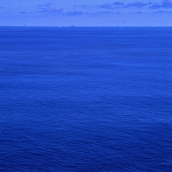Geography of Savage Islands
The Savage Islands are located at around 100 miles north of Punta de Anaga, in Tenerife, and almost 160 miles south-southeast of São Lourenço, in Madeira (1 mile = 1.8 km). They include three small islands (Selvagem Grande, Selvagem Pequena and Ilhéu de Fora) and several islets, and are surrounded by ledges and reefs that make for dangerous navigation in this part of the Atlantic.
Selvagem Grande is the largest (4.5 km2) and the highest (151 m). It is a roughly rounded plateau, practically flat on top, with sheer sides that drop abruptly into the sea. The higher section, around 100 m above sea level, is a broad plain with three promontories: Pico da Atalaia (151 asl), where one of the lighthouses is located, Pico Tornozelos (137 asl) and Pico do Inferno (107 asl). When the atmosphere is clear, you can enjoy a perfect view of Mt Teide (Tenerife) from here. The coast is heavily eroded from being pounded by the sea, and abrupt cliff walls render the island largely inaccessible. Moreover, it is almost entirely surrounded by reefs, outcrops and rock platforms. A small jetty is located on the leeward side, at Enseada das Cagarras, where there is a house for the keepers of the nature reserve. From this point, two paths head off towards the upper plain.
Selvagem Pequena (0.3 km2) is low and mainly covered with organic sands of marine origin. At the western tip there is a small promontory, Pico do Veado or Atalaia (49 m asl), on which another lighthouse is located. At high tide, a large area of the eastern side is submerged. It is possible to land on a little beach located to the southwest, sea conditions permitting. Nearby there is cabin accommodation for the keepers.
Ilhéu de Fora is low and small (0.1 km2) and almost entirely covered with organic sands. There are only two large rocky outcrops and the highest, barely 15 m asl, is located at the south-eastern tip. A long shallow platform fans out towards the north, dotted with several islets and a few rocky outcrops. There are no buildings on this island and disembarking is extremely difficult.
Generally speaking, the Savage Islands have a subtropical maritime climate, similar to the coastal climate of the Canaries. Their geographical location exposes them to the cold waters of the Gulf Stream and the trade winds that blow from the Azores. Because the islands are low-lying, the trade winds cause very little precipitation. However, the combined action of the wind and the cold waters that surround the islands help keep temperatures cool for most of the year. The Atlantic squalls that blow in from the North and West, bringing torrential rains and electric storms, generally last for just a few hours. Occasionally, masses of hot dry air blow in from Africa, sometimes carrying Saharan dust in suspension, as in the Canaries when wind direction is from the south.













